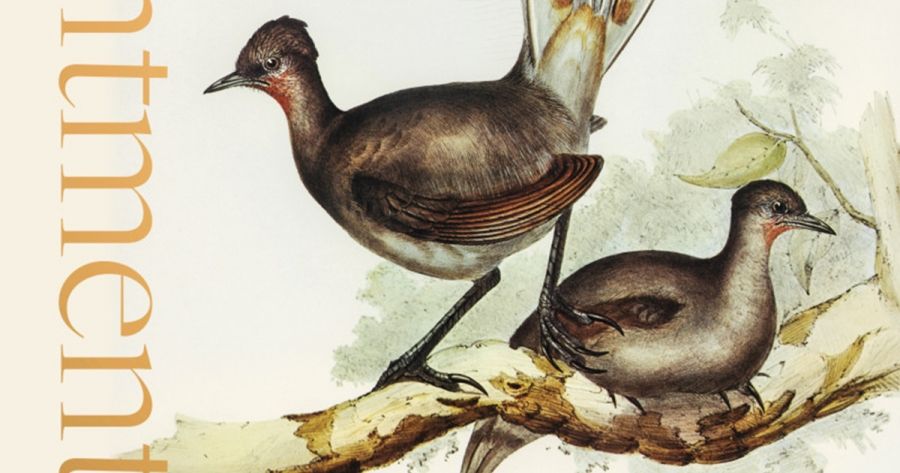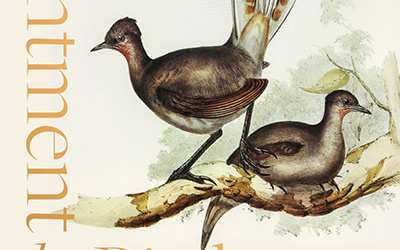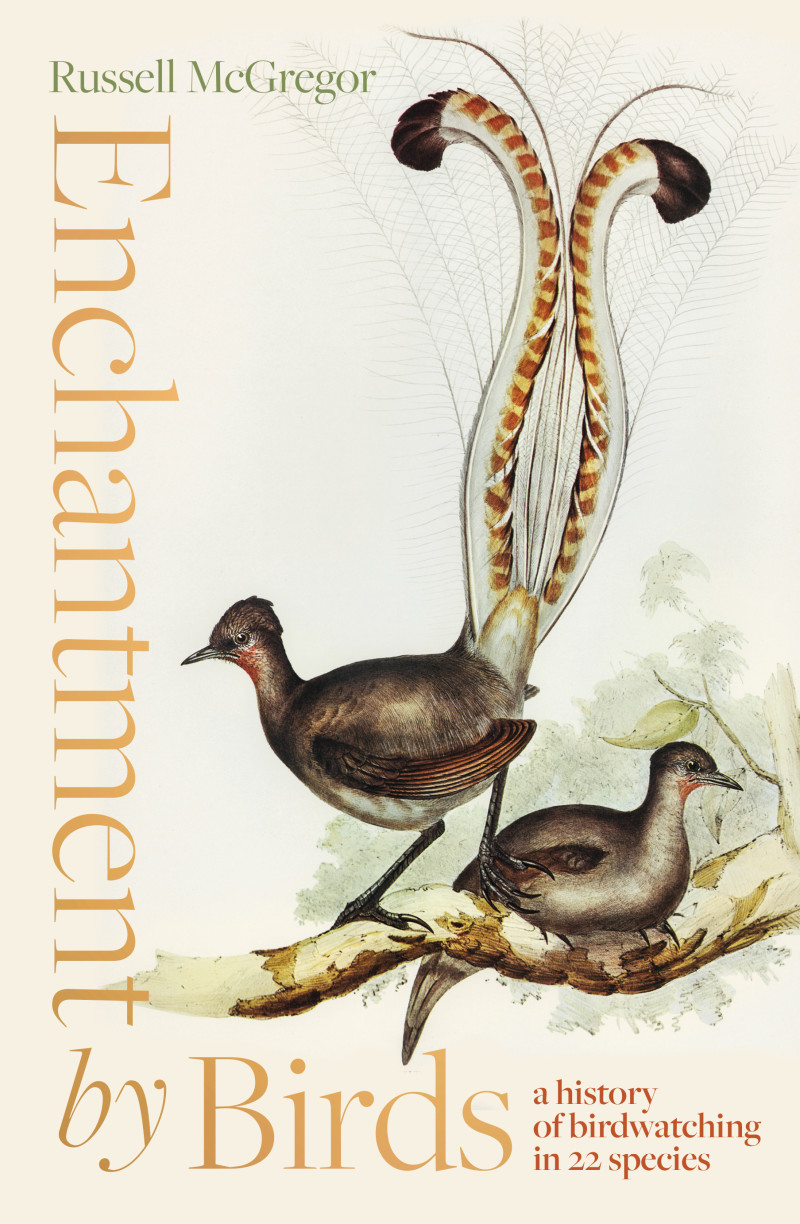
- Free Article: No
- Contents Category: Ornithology
- Review Article: Yes
- Article Title: Spotting Yellow Chat
- Article Subtitle: Australian birding culture
- Online Only: No
- Custom Highlight Text:
Early on in Russell McGregor’s new book on the history of birdwatching in Australia, he highlights the importance of the initial epiphany most birdwatchers experience when their interest first sparks. This moment of what Julian Huxley called ‘sudden glory’ can happen anywhere and at any time, city or country, day or night, and often fans out into an obsession, sometimes a profession, that endures through a lifetime.
- Featured Image (400px * 250px):

- Alt Tag (Featured Image): Gregory Day reviews ‘Enchantment by Birds: A history of birdwatching in 22 species’ by Russell McGregor
- Book 1 Title: Enchantment by Birds
- Book 1 Subtitle: A history of birdwatching in 22 species
- Book 1 Biblio: Scribe, $39.99 pb, 309 pp
- Book 1 Cover Small (400 x 600):

- Book 1 Cover (800 x 1200):

- Book 1 Readings Link: https://www.readings.com.au/product/9781761381447/enchantment-by-birds--russell-mcgregor--2024--9781761381447#rac:jokjjzr6ly9m
This is what happened to me when I was in my late teens and a Great Egret caught my eye while it was fishing behind the dunes. I had lived with birds my whole life, but for some uncanny reason my senses and sensibility were only then sufficiently ripened that the beauty and delicate hypersensitivity of the glowing white egret could make an impact. I stood transfixed, noticing how poised and precise the bird was and how alert it was to my every slight movement, even though I was standing back up among the sea box some fifty metres or so from where it was fishing. This was the same water I had revved up and down in our purple motorboat on school holidays, quite oblivious to the birds. In that single and unexpected moment, my relationship to the place where I now live was transformed forever. It was the appreciation of the egret that triggered the change. I suppose another way of putting it would be to say I was smitten.
McGregor’s Enchantment by Birds is a treasure trove of accounts of other Australians who have been likewise smitten and then gone on to spend their entire lives cultivating a relationship with birds. Unsurprisingly, McGregor, as well as being a historian, is one of these types himself and the book begins with an account of his first sighting of the Capricorn Yellow Chat, which he finally spotted, after two days of questing, among the samphire near the mouth of the Fitzroy River in Queensland. The sighting of the Capricorn Yellow Chat brought him a thrill familiar to all birders, be they professional or amateur. McGregor’s pleasure had a further and uniquely personal layer because it was his great-great-grandfather John McGregor who first ‘collected’ a specimen of the Capricorn Yellow Chat, all the way back in 1859.
McGregor’s ancestor shot the Chat and sent ‘the skin’ to the museum. This was fairly standard procedure for proactive colonial bird lovers with a scientific bent. The difference between his approach and that of his present-day descendant, who ‘collects’ birds via his camera lens and pen rather than with a gun and preserving alcohol, forms a central and fascinating narrative thread to this impressively balanced account of how Australians have gone about indulging their fascination with birds.
McGregor divides the book into twenty-two chapters, each titled with his own playful version of binomial nomenclature. Chapters are assigned a particular bird species, which in turn forms the central motif for a discussion of a signature component of birdwatching culture. Early on, for instance, the mellifluous White-throated Gerygone is used as a conduit to discuss the fascinating issues around the ways we appreciate and record the melody and music of birds. A little later in the book, a chapter on the Crested Tern, officially the subject of Australia’s first bird photograph, extends the story of how the gun was replaced with the camera as the chief instrument of the bird collector. McGregor’s design is an efficient and entertaining way to structure the complex aspects of birding culture that his book surveys.
The fact that the horrific, mechanised slaughter of World War I dovetailed with the transition from gun to camera within the birding community is instructive. The 1920s saw the use of cameras take hold. Inevitably, arguments over collecting methodologies continued to flare up, never more so than in the walk-out led by the legendary birder Keith Hindwood at the 1935 Royal Australasian Ornithologists Union campout at the mouth of the Snowy River, when museum curator George Mack shot a nesting Scarlet Robin ‘in full view of the campers who for the preceding few days had been admiring the bird carrying out its parental duties’. It is typical of McGregor’s balanced approach that he informs us that it was not that Hindwood was puritanically opposed to collecting per se – he had often used skins from the Australian Museum to illustrate his bird talks – but that with photography now de rigueur, in this particular instance ‘he was disgusted by Mack’s wanton act of bloodshed’.
A few months after my transformative teenage encounter with the Great Egret, and with a new set of eyes and ears for all the birds in my home area, I pointed out to my father two spur-winged plovers which we had startled from the slushy roadside as we drove by on our way home from yabbying. I was in the first flush of my avian love affair, so I was shocked but, I must admit, amused to hear Dad’s old-timer response. ‘Yes, plovers,’ he said. ‘A surprising amount of meat on the breast.’ Dad already knew many of the birds I was just beginning to register, but he knew and loved them as food for hunting as much as anything else. McGregor’s book demonstrates how the ethics of our love for birds are anthropocentrically complex and can, on the surface at least, appear contradictory. They are also, as his absorbing discussion of the rights and wrongs of feeding birds shows, very much bound up in the fashions of the day.
One of the most refreshing aspects of the book is its emphasis on human collaboration in the service of birds. In this, McGregor refines and develops the ‘mateship with birds’ ethos of Alec Chisholm, of whom he published a fine biography, Idling in Green Places, in 2019. Enchantment By Birds is full of anecdotes about the exploits of Chisholm and many other remarkable bird lovers in our recent history. It also documents some of the great work currently apace combining the vast knowledge of local Indigenous science with European models. As McGregor points out, no matter which category of birder you belong to – twitcher, ornithologist, custodian, artist, hunter, or writer – you are bound to share qualities with those in the other categories.


Comments powered by CComment